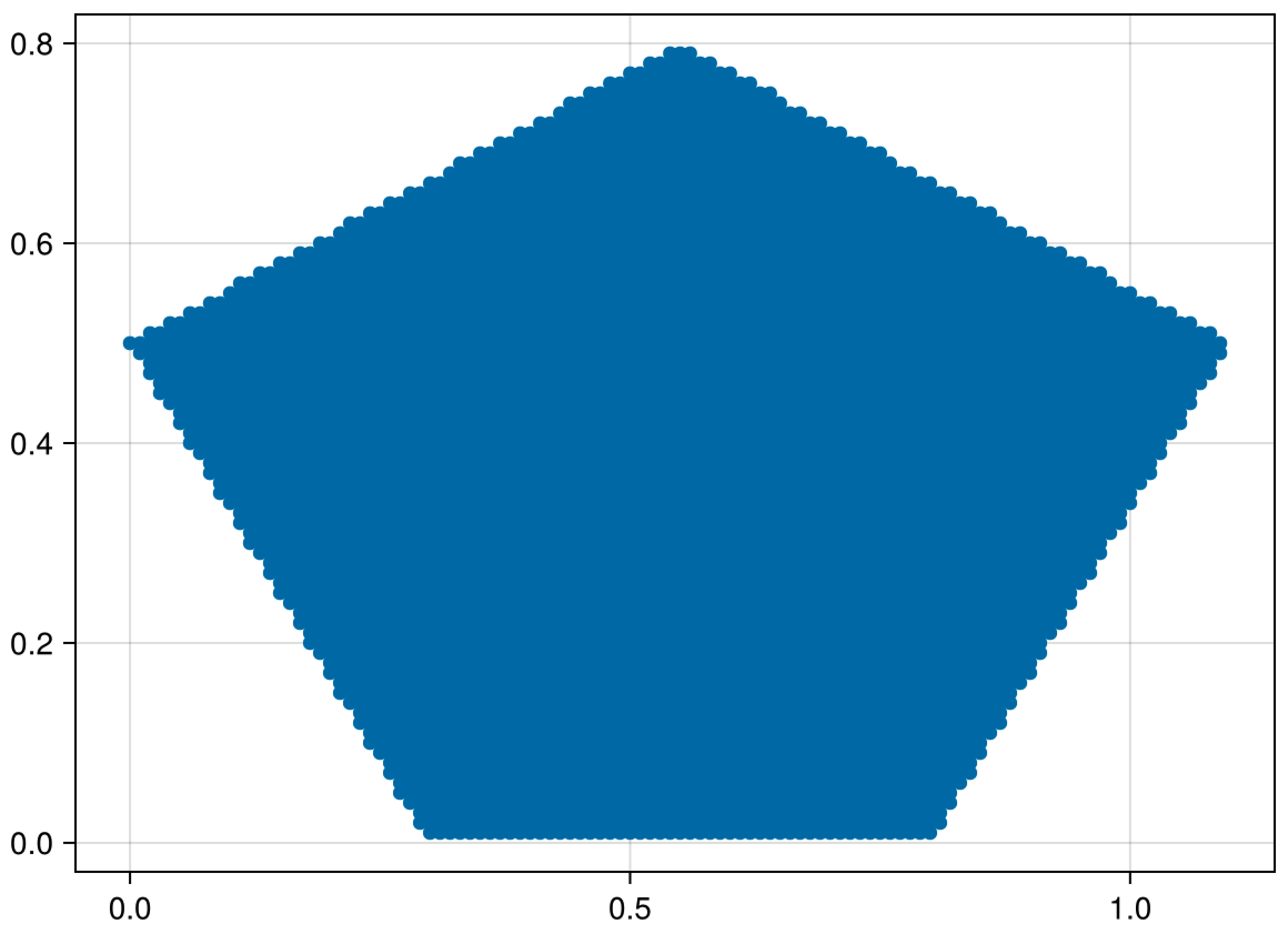Polygon
For the two-dimensional polygon model, we consider two cases: 1) simple polygons, which have no holes in their interior, and 2) complex arbitrary polygons.
For the first scenario, we simply need to input the vertices of the polygon in a counterclockwise order, and then MaterialPointGenerator.jl will automatically generate uniform material points of the specified size within the minimum enclosing rectangle (AABB) of the polygon. It will use the winding number algorithm to determine whether each material point is inside the polygon. This process does not take much time for simple polygons, and we have enabled multithreading by default (make sure to configure the correct number of threads when starting Julia).
For the second scenario, to support complex polygons in any situation, we need to utilize some preprocessing software. Here, we recommend using Gmsh, which is not only open-source and powerful but also offers a user-friendly GUI, making it very easy to get started. We first create the model in Gmsh, where we can determine the precision of the triangular mesh according to our needs (there are many tutorials on Gmsh available on YouTube). After that, we export it as a .stl file. While other formats can theoretically be used, we always recommend sticking with the .stl format. Next, you simply need to read this file and specify the grid size (the grid size in MPM simulations), which is very straightforward!
Simple 2D model
We are preparing to discretize a two-dimensional pentagon, noting that the specified distance is between the material points in both the x and y directions.
MaterialPointGenerator.polygon2particle Method
polygon2particle(polygon, lpx, lpy)Description:
Generate structured particles from a given polygon. Note the vertices of the polygon should be ordered in a counterclockwise manner; otherwise, it may lead to incorrect results.
lpx and lpy are the space of particles in x and y directions, respectively.
polygon is the polygon, for example, polygon = [0 0; 2 0; 2 1; 0 1] means generate structured particles in a rectangle area.
julia> polygon = [0.3 0.0; 0.8 0.0; 1.1 0.5; 0.55 0.8; 0.0 0.5]
julia> pts = polygon2particle(polygon, 0.01, 0.01)
223×2 Matrix{Float64}:
0.03 0.49
0.08 0.39
0.08 0.44
0.08 0.49
0.08 0.54
0.13 0.29
⋮
0.98 0.54
1.03 0.39
1.03 0.44
1.03 0.49
1.08 0.49
Arbitrary 2D model
Please use pre-processing tools like Gmsh or MeshLab to ensure that the current mesh is closed in advance.
MaterialPointGenerator.polygon2particle Method
polygon2particle(stl_file, output_file, h; verbose=true)Description:
Generate structured particles from a given .stl file. The particles are generated by voxelizing the 2D space of the STL model. The voxel size h should be positive.
Advanced
This involves some advanced operations for partitioning the generated material points. There are two ways to achieve this: 1) directly determining whether the current material point is within a specified polygonal area, and 2) using the concept of physical groups in Gmsh to differentiate the model during the meshing phase.
For the first case, we can utilize a practical function to check if a point is inside the polygon.
MaterialPointGenerator.particle_in_polygon Method
particle_in_polygon(polygon, px, py)Description:
Determine whether a point [px, py] is inside a polygon. Note the vertices of the polygon should be ordered in a counterclockwise manner, it is better to use the function getpolygon to get it; otherwise, it may lead to incorrect results.
Example:
polygon = [0 0; 2 0; 2 1; 0 1]
particle_in_polygon(polygon, 0.5, 0.1) # check points (0.5, 0.1)For the second case, in addition to the .stl file, we also need to provide a .msh file.
MaterialPointGenerator.polygon2particle Method
polygon2particle(stl_file, msh_file, output_file, nid_file, h; verbose=true)Description:
Generate structured particles from a given .stl file and .msh file. The particles are generated by voxelizing the 2D space of the STL model. The voxel size h should be positive.